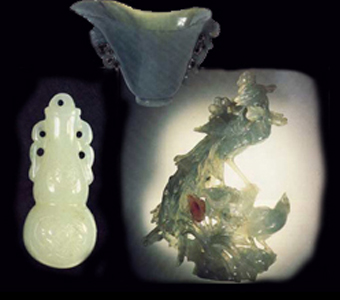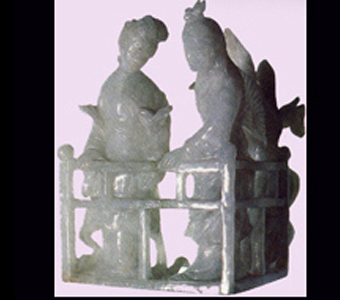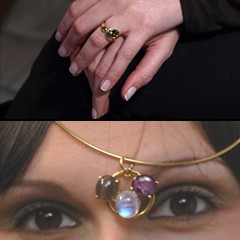

There are stones that are particularly linked to the culture of some people’s. Jade excels among these. I was in Hong Kong. In local fairs, markets, jade was offered everywhere. Tiny cabochons worth thousands of dollars, intricate carvings for a few dozen! I was unfamiliar with this culture, and to this day I strive to understand but remain confounded.
Imperial jade owes its name to the fact that only the emperors, and their families, had the right and the social burden to wear jade objects of that color. Then there was the mandarin jade, and gradually the other colors for the various castes in which their society was stratified. So this stone was distinctive of the owner’s social rank, and for this reason it was always handed down over the generations.

Medallion in green jade. Often jades must be viewed against the light, to better appreciate both the color, and the expressiveness that the artist has meant to infuse us with. Backlight is a typical mode of expression of many artists from the Eastern hemisphere; a typical example are their ceramics, which, if seen against the light, often show delicate images, imperceptible with ordinary lighting.
A jade bracelet was given to adolescent girls. With the growth of the child, the cuff could no longer slip out. When she had grown old, as happens to all the old, the arm would be thinned to the point that the cuff would easily slip off, to be donated to her granddaughter. This bracelet was a chain between the generations, and it was crammed with a thousand cultural, historical, social, magical, traditional meanings.
To ensure that the bracelet could be passed from one generation to the next, it needed to be passed on unbroken, to do this you could not ponder a too heavy or risky labor. She also had to lead a healthy life, and be in the condition to grow old enough to be able to remove the armband from her, by then, thinned wrists. At the jade market, such bracelets were on sale. They had very high prices, and those that had been cut into two pieces definitely cost less. The details of precious stones are derived from its single particular crystals. To their crystalline nature they owe their transparency, which only rarely appears in the massive rocks, and in microcrystalline agglomerates. Jade is opaque or translucent, and it is a conglomeration of Microcrystals.

Jug in green jade. There is excessive attention to detail, both in the excavation process of semitransparent jars/pots, as in the enactment of ring chains: both demand outstanding mastery.
Its greenish, lavender, pinky, milky colors are very delicate, and are often used to color with emotions floral or sweet female vision scenes in melodic sculptures.
Currently jade has an important historical task. The visitor who goes to Hong Kong, can be dazzled by the dynamism of a modern metropolis. Everything is advanced technology; the patterns of life and Western costumes are text, and the western is the privileged customer. The jewelry, in style and quality, is similar to the European style. But not when it comes to Jade! Here no one surrenders to their roots: not at all! Here the style continues on a culturally different path from ours, and we can only sense the greatness of this pathway. We find ourselves, however, in great difficulty to fully partecipate in the emotions that these stones give the Eastern hemisphere. For us, the Jade is a beautiful stone, among many other beautiful stones. For them, jade is “THE” stone, and this can put us ill at ease.

Lavender color small statue, with a couple at the balcony. The latter, in societies where the legacy of social castes is still present, has a particular symbolism: the noble family oversees from above; it is protected, but it is not confined to its quarters.

Jade pendants of different colors, depicting floral games, magic symbols, dragons. Note how the stone, which has a considerable hardness, can interpret something soft.
Specifications.
JADE, or jadeite, is a monoclinic pyroxene, while NEPHRITE belongs to the amphibole (actinolite) group. These are two very similar minerals in appearance and color, but different mineralogically. Often, these two varieties of stones have been sold under the same “jade” name.
CRYSTALLIZATION: monoclinic system. We are dealing with micro-crystallization.
CHEMICAL COMPOSITION: sodium and aluminum silicate.
CHEMICAL FORMULA: NaAl (SiO3) 2.
HARDNESS: 6.5-7.
SPECIFIC WEIGHT: 3:30 to 3:40.
REFRACTION: biaxial, double (+ 0029).
REFRACTIVE INDEX: 1.66 – 1.68.
THERAPEUTIC AND TRADITIONAL MAGIC PROPERTIES: efficacious against kidney diseases. It also protects in defiance of lightning, so it is a good idea to brick a piece up laying the foundations of buildings.
USE: for many millennia jade has been held in high consideration for many different reasons: magical, ornamental, ritual, medical, musical/instrumental, horoscopes, family traditions, meditation, as a support for carving propitiatory phrases, and so on and so forth.
QUOTES. “It is soft, smooth and glossy just like kindness is; it is strong, compact, stunning just like intelligence is; it has sharp edges, but does not cut, such is justice; it is very beautiful while it does not hide its defects, such is truthfullness; its essence is contained within streams and on hill-slopes; it shines like the Heavens and, if struck, it emits long and clear notes; this is no other than heavenly music.” (Confucius- 551-479 BC)
MAIN DEPOSITS: it is found in both primary and secondary deposits. Myanmar, Turkestan, China, Tibet, Mexico, Costa Rica, Venezuela, Alaska, New Zealand. Of course each field produces a particular material, and within each field you can have countless different qualities.
COLOUR: As well as countless natural tones, keep in mind that the more washed out and pale specimens are, in any case, “reinforced” colors, after refined chemical processes.
STONES SIMILAR TO EACH OTHER: Jade, Smithsonite (zinc spar), Vesuvianite (idrocrase), Sillimanite, Nephrite, Smaragdite, Verdite, Serpentinite, etc. Of course there are also artificial paste gemstones that can be misleading.
RECOMMENDATIONS: A stone that can fascinate, but that can fool. We advise the upmost caution: especially true for the most valuable samples, extremely difficult to definitely evaluate, specifically in the West.
IMPREGNATION: Often, jade is porous. This creates difficulties in the polishing process, and gives it the tendency to get contaminated irretrievably. For this reason they are soaked in particular resins that make them more compact, without altering their natural characteristics. Once, paraffin was used, nowadays, more stable high-performance resins are endorsed. The problem arises when, instead of colorless resins, colored ones are adopted. The serious merchants will always claim the type of treatment that the stone has gone through.




























